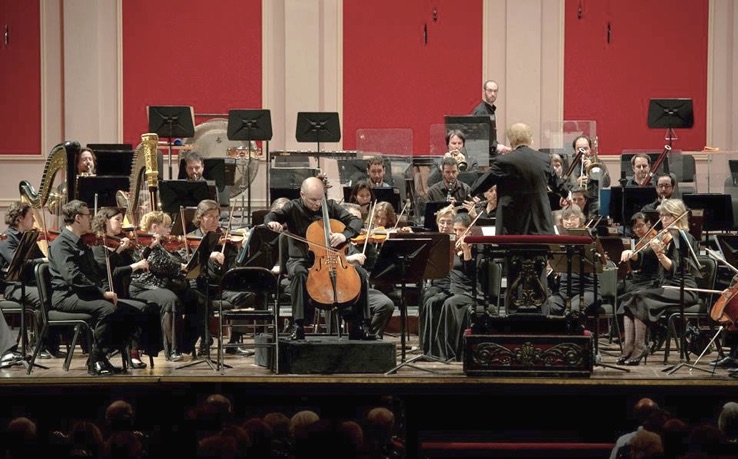"In order to learn, I compose music."
Pascal Dusapin is difficult to classify as a composer. He has written many large scale works: 7 operas, 11 Concertos, his orchestral cycle 7 solos spans over 17 years, yet at the same time he has written a huge amount of solo pieces and chamber music often of the most intimate kind. He studied architecture, he exhibits as a photographer and recently made a sound and video installation filling a whole sports hall in Donaueshingen. He studied many subjects linked to composition yet he didn't study composition.
Pascal has a huge appetite for music; you don't see many composers as often in concerts in Paris - especially after the passing of Henri Dutilleux - and I don't know anyone with a more impressive studio for listening to music. He has a very interesting way of listening to recordings, he often points out aspects of sound and acoustics that would seem secondary for a normal listener. I have a feeling that listening is an important part of composing for him. When I asked him to give an example of how listening might influence his music he gives this example: "This morning I was listening to a an old recording of an early Haydn Quartet. The simplicity of Haydn's phrases, the perfect architecture of the form and the perfect performance made me feel a kind of state of grace, which was very real. That feeling was what I brought with me when I sat down at my desk to compose. It gave something concrete, yet unobtainable to reach for."
"In my music form has become style"
One important influence for Pascal was Iannis Xenakis, their relation lasted from the beginning of his interest in composing until the end of Xenakis's life. Pascal insists Xenakis was not his teacher but his "Maître", he learned with Xenakis. Xenakis's background as an architect and the fact that Pascal's two brothers are architects themselves led him to study architecture, not to become an architect, but as part of his quest for understanding form. Form and shape are the first things one feels when listening to a piece by Dusapin.
Pascal has had long collaborations with many musicians: the Arditti String Quartet, the baritone Georg Nigl, Accroche Note-ensemble, clarinettist Armand Angster, cellist Sonia Wieder-Atherton etc. When I talk to him about his relations with these musicians, I feel the collaboration is more on a human level than on a technical one: "Contrary to many of my contemporaries I never did workshop kind of work with my performer friends. I have a very human, loving relationship with all of them, they are simply the people through whom I have learned my craft. I can't really say I collaborate with them during composing, I write partly for the person who is going to perform the piece and partly I invent that person in my head. When I wrote the Violin Concerto for Renaud Capuçon I kept writing for him and yet not for him. By now I have worked with Georg Nigl so much that I feel I know his voice by heart, I know how he reacts and his way of phrasing, but when I write something for him I don't want to be locked inside him or inside my idea of him, it has to be the piece itself that invents the performer."
"Music is condemned to time"
The better I know Pascal, the more I see how he loves people, music, literature, films; he loves to talk about all of them and often explains his own music through them. When he sits down to compose, he walks his own path, any influence from anybody or anything is on a subconscious level. This gives his music a feel of timelessness, it is music that found its way to him and allowed him to write itself.
Anssi Karttunen, 2015
(text written originally for the program book of Musica Nova Helsinki 2015)
___________________________________________________________________________
Programme notes for Slackline:
Pascal Dusapin wrote Slackline for cello and piano, dedicated to Anssi Karttunen, in the summer of 2015 soon after finishing Outscape, his second cello concerto. Slackline is in four movements which are both contrasting and related, consequences of each other. The reflective first movement explores the extreme registers of the two instruments, hinting at conflicts. The almost impossibly fast second movement allows in recognizable influences from other genres. The third movement opens up a vast landscape where the anxieties of the previous movements have frozen, not disappeared. The last movement is the explosion of the inevitable, leading eventually to acceptance. The piece which never offered any illusion of optimism finishes in mature tranquility.
Composed exatly 100 years after Debussy's Sonata for cello and piano, Slackline is in its size and emotional scale a direct continuation in the tradition of the great instrumental duos of the late 19th and early 20th centuries.
© Anssi Karttunen (2016)
Pascal Dusapin composa Slackline pour violoncelle et piano, dédiée à Anssi Karttunen, au cours de l’été 2015, après avoir fini Outscape, son deuxième concerto pour violoncelle.
Les quatre mouvements de la pièce sont, en même temps, contrastés et liés, conséquence l’un de l’autre. Le premier mouvement, réflectif, explore les registres opposés des deux instruments, insinuant un conflict. Le deuxième mouvement - dont la rapidité va presqu'au-delà du possible - introduit des influences assumées provenant d’autres genres. Le troisième mouvement éclôt sur un vaste paysage où les anxiétés des mouvements précédents sont figés, pas disparus. Le dernier mouvement est en soi l’explosion de l’inévitable, menant finalement à l’acceptation. Cette piece qui n’a jamais offert un optimisme illusoire, s’achève en une traquille maturité.
Composée exactement 100 ans après la Sonate pour violoncelle et piano de Debussy, Slackline est par sa dimension et son échelle émotionnelle une continuation directe de la tradition des grands duos instrumentaux de la fin du XIXe et début du XXe siècle.
© Anssi Karttunen (2016)


